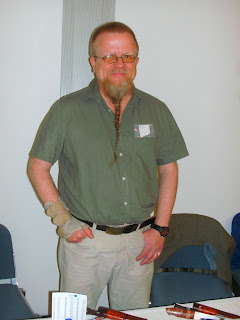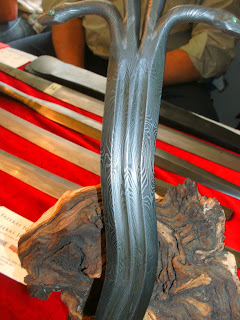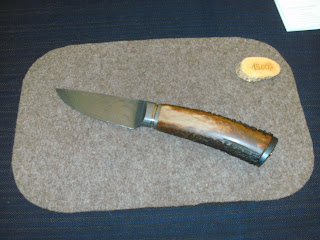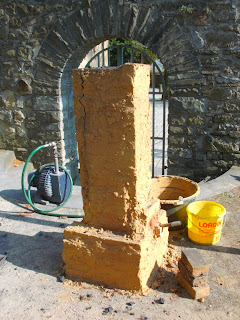It was a beautiful sunny Saturday, and I arrived at the early afternoon, and took a stroll through the beautiful cob house city streets.
The museum is located in an old medieval monastrey building, looming over the city.
I paid my entry fee, and just some two steps into the museum the mayhem began. This is the booth of Peter Sederl with top quality folding knives...
..and beautiful hunting knife designs to boot!
I found this bushcraft sheath most appealing, although I am not sure why one does not make a proper loop for the ferrorod. This way is most popular, and I have made that, too, but I tend to loose those sticks, and no fire is not good in the wilderness!
Thisis the maker to the left of the photo, and the friendly gentleman with the "Weissbier" is Noriaki Narushima. The picture illustrates the atmosphere of the expo very well... lots of friendly, good - natured people having a lot of fun!
Two booths farther into the room, I met with JT Palikkö, a master knifesmith and master swordsmith from Finland. JT had a lot of extremely well-made swords at hand, highly polished to a high lustre, and I was actually amazed to learn that those were made from high-layer damascus. He recycles a lot of high - carbon steel, too, and many of his damascus blades are actually made from historical spring steel. This is a craftsman to be mentioned in the same line as those ancestors who forged swords. Plus, he´s a friendly, crazy guy, and I really liked to chat with him.
We both raved about the cutting prowess of the "Kopis" blade style, and I felt thoroughly understood;-).
JT, this was a jolly meeting! Thanks for that!
The guy next to him was of the same stamp;-). Maihkel Eklund from Sweden presented his extremely well-finished damascus, three-layer laminate and mono steel knife blades, knives, and axes / hatchets, among the latter this outright crazy interpretation of a mini hatchet:
Gilded and finely engraved axe blades anyone? This is the maker himself. Normally, he wears a teenie-weenie-mini fixed blade knife in its sheath in his beard, no kidding;-), but he sold it... we had a short, but good-natured chat, and I hope to repeat that sometime soon!
His blades, amazing work obviously, sold for an outright bargain price. When you consider many knifemakers in Germany with a CNC-lathe want to have ridiculous fairy-tale prices for work that´s not even handmade, this is very refreshing, and a sign that he has got his craftsmanship wired as well as his pricing!
In the next aisle I met with Matthias Maresch, a former student of Uli Hennicke, and his lovely companion. I really like the fluent lines of his knives that are aesthetically appealing but not impractical.
He also had these all-metal tactical knives with kydex sheaths on display. Not my piece of cake, certainly, but one has to admire the craftsmanship!
The maker and his lady....
At their back was the booth of Mr. Lasky, a Hungarian maker, and what did I find there?
A very interesting bushcraft knife approach. Damascus from high-carbon Böhler steel with a striker handle and a razor-like hollow grind. This knife would make for a great neck knife for around the local woods, and could as well be the gag on the next barbecue party. It´s certainly no survival knife, but makes a good backup and little task knife.
This is Mr. Lasky´s lady demoing the striker handle. We had our communicational challenges;-) yet managed well with English, hands, and grins and smiles. Message!;-)
I passed by the booth of Mr.Kutz... great friction folders on display that would even be legal in the UK.
We had a laugh together, a nice chat, and I admired these knives on display, quite to my liking. I love the bolster designs on the hunting knives a lot! Unfortunately, he has no website, and I did not want to link his email address, for obvious reasons...;-)
Oh, and I did not want to keep the expos of the museum away from you, either. There are blades of knives, table cutlery, swords and edged weapons on display from the bronze age to modern times.
I was very fond of these Persian, Scythian and Andronovo bronze hatchets. I want to do some more research on the topic. Of course, I only had half a mind for the artifacts, but am resolved to come back soon to do it more throughly.
And i daresay the mindset of those ancient smiths might not be very far off from that of those smiths and makers on the show.
The picture above are Celtic examples of a weapon sacrifice. This practice was quite common with weapon sacrifices. Swords were often damaged in an act of supreme violence. Keeping in mind these swords are tempered, and well tempered, one could imagine what force had to be applied to bend them this much. It is also a testimony on the tempering skills of the swordsmiths of that age!
I am really fond of these two Celtic ring-pommel knives. Presumeably a predecessor of the Vimose seax morphology, the big knife would be used in a similar type to the seax. Both knife types were found as equipment in burial mounds when a piece of meat was present as a burial gift.
Then I met with Stefan Steigerwald and his wife. Stefan has a shop for any material imagineable for knifemaking, blades and billets, tools and lots of good advice. He, too, is a very nice guy, and I did not need much persuasion to buy ramshorn scales and a piece of reideer entler from him. Visit his shop here.
He also makes nice art knives, not my piece of cake, but there´s a gallery here. Again, we had a nice talk, and blimey, I did not manage to see all there was to see. One day certainly is a bit short with all the people to meet!
Then I met with Peter Abel, and I can say, he has a kind of humour that is illegal as felony in 48 states of the US*ggg* no offence meant, by the way. I simply like him, for he´s a friendly guy, and a master smith ready and eager to share his knowledge. He always answers questions, even if you don´t buy anything and linger around with a camera to take lousy pics of his booth. He offers blacksmithing tutorials and material for gas forges, forges, knifemaking and a lot of special knowledge. Here he offers everything you might possibly need as a knifemaker and goodies for the blacksmith.
His knives are definitely my style, but he does it so much cleaner than myself. I was amazed to learn that the knife at the upper right came out too clean for his liking, so he whacked some hammer dents in on purpose! He can do it "tribal" and archaic, but also had some very clean kitchen knives on display, drop-forged from Damasteel!
He also offered a vast array of blades for quite reasonable prices.
Then I went upstairs to visit Mr. Fazekas, meanwhile a kind of aquaintance of mine, for we meet several times a year, and always exchange some politeness. Mr. Fazekas is a friendly man with a calm air and amazing skills as a knifemaker and blacksmith.
This Keris dagger certainly was one of my favourites of the show, for the skill with which it was accomplished. Four strands of torsional damascus were separated for the hilt and crossguard. Then they were forged into snake heads with emeralds set into them as eyes. Personally I like it also for the mythological interpretation of the keris approach.
It was somewhat funny; I had talked so much English that day, that I inadvertedly addressed Mr. Fazekas in English too;-). He smiled and simply said "Deutsch ist doch besser" (German would be better). I apologized. He smiled. Then I smiled, too. Message!*ggg*
He also had these Wkizashi and Tanto blades on display, made from thousands of layers of refined file steel. Note the Hamón on the blades!
A detail of the Keris handle.
And the blade.
This is the (deserted) booth of Peter Johnsson. I missed his lecture on sword making, and I regret the fact, but not the fact that I missed it while talking to JT Palikkö and Maihkel Eklund. However, Peter is another very great individual that I had had the privilege to meet several years earlier, a very reflected person with-must I really rant on endlessly about his skills as a swordsmith? He is a legend, but well down-to-earth. You can get his works as functional replicas at Albion amoury at a reasonable, albeit not cheap prices, but I daresay it would be better that not every punk can afford one of these weapons;-), for they are as deadly as their historical ancestry. Most interesting, however, are his theoretical works, which have thoroughly enlightened my technical understanding as well as my understanding of medieval martial arts, culture and literature. It is always funny to ask visitors in the smithy how heavy they would estimate a medieval sword. The funniest guess I got was 25 kg! I once did not know the correct number, too, but Peter Johnsson was the one shedding light into the topic years ago. And even if my guess was much closer to the mark, I would never have understood there were swords as light as 500-700 g, and the physics of swordplay were far from the clumsy dance we are led to believe from stage combat. Learning from his scriptures certainly has made me rethink utility knife design, too. So, Peter, you have influenced me very much, and thanks for that!
On I went, and came towards the booth of Gerhard Wieland. Ever since I saw his first official works;-) in the early Messerforum, I was amazed by the harmony of his design, the flowing, almost art nouveau - like lines and the meticulous craftsmanship. His knives preserve the air of the archaic while being far from rustic.
I daresay the pictures talk for themselves. Gerhard Wieland does use a hammer, tongs, a gas forge and a file, period. It makes me feel a bit ashamed of my own achievements...
I also like the (true) Hamón lines on the blades.
This is his trademark elk sculpture, for he is fond of Scandinavian culture. His knives always have to stand their test in holidays in the Scandinavian bush, so no petty mayflower steel!
Then I went on, and to another extraordinary smith. Andreas Schweickert is famous for his very eloquent Wootz-knives, but also his simpler designs. I was amazed by this knife. If you have read my blog, you know that I am quite fond of this style of knife. But to date I have never accomplished something as eloquent as this! My respect goes to the maker, for I know what stands behind it!
This is one of his Wootz blades with a beautiful stag handle.
But he can do it rustic, too. Tribal design Parang machetes.
Historical carving sets and eating knives on display by the museum for comparison. I daresay there´s not so much difference except for the common expressions of fashion and taste!
Then I ventured outside, where in the museum´s garden there was a Kyudo demo going on. It was fascinating to see the meditative air of the drawing and shooting. Hitting the target is a goal, but not of priority. Even as important is the process of breathing, aiming, and concentrating. It is commonly known that Zen archers are able to hit the target blindfolded, and I relate this to the setting of different priorities. One could say that the target is secondary, because it will be hit in any case. It was simply great to see meditation in practice.
Then I came to the last station of my visit. The booth of Achim Wirtz, Norbert Bahls, and my own personal mentor and tutor, Matthias Zwissler, where they had a Tatara oven running.
And whom did I meet there? Rolf his self, Gunnar, and Willy lingering around and talking rubbish. So I stood me next to them and helped them talk rubbish, too...*ggg*
This is Matthias. I owe him more than I can say. He has no easy life, but he clings to his passion, and I hope he will for the time to come. Keep the fire burning!
The tatara oven. They used charcoal and iron oxide to achieve a bloom, which is then forge-refined by forge - welding. This is the master skill of blacksmithing, and these guys have it wired. They are blacksmiths that really deserve the title "metallurgist". Period. I could say more, but it would not do them justice. It is my goal to one day come a bit closer to these skills. Not much else is as important.
This is a seax blade by Achim. Must I say more?
A Spatha billet in the making.
And some rustic user knives and a foraging sickle.
Left is Norbert Bahls, then Mrs. Wirtz (presumeably), and Achim Wirtz.
There was a lot of tech talk going on. Willy is listening intently, for there was much to learn in but a minute of conversation.
Then suddenly we went outside, and Willy and I had a good chat in a nearby café, and we talked a lot about what we had seen, about old times and the times that are yet to come. It was a great day with great people, with old and new aquaintances and, more important, a feeling of being someone and belonging somewhere.
Face it: I am a freak of nature. Be it in my job, in my social life, in my leisure, I have always been an outcast, and the so-called normal people have not held back their opinion about the value of my doings and whereabouts. I have been mobbed even in the Kindergarten, in school, in my job, even in the clubs I founded and helped found.
But fire and steel is something else than leisure. It goes deeper and deeper into the deepest regions of my soul. It would not stop if I could not forge anymore. For I, for one DO have a soul. I do not belong to the people I met, and they don´t belong to me, and most of them would laugh at me for trying to find these words. But they, in turn, belong to fire and steel. There´s not much more to say about that. If you cannot feel it, every word is futile, and futile it is also to tell it to those who can feel it. If you work with steel and fire, if you allow it to scar you, to burn you, and don´t give up fighting, chance is, you will eventually be able to hear the song.
The song of steel, as pathetic as this might sound. But I cannot say it in any other way. The expo was full of people trying to listen. I have to apologize to them for trying to speak about something which is not to be spoken about, for talk is cheap.
To the forge, then.





























































